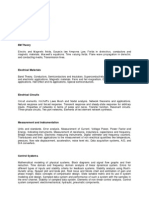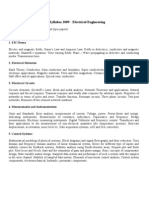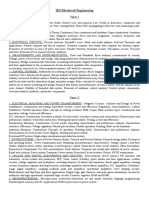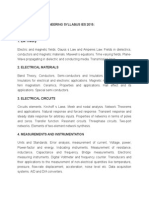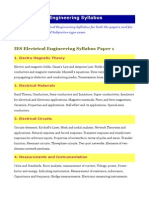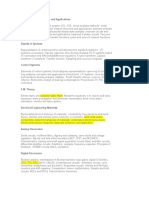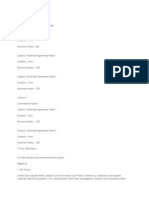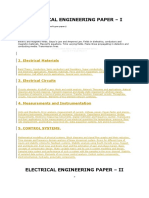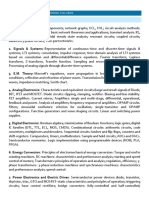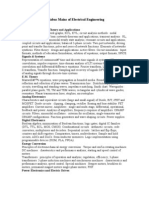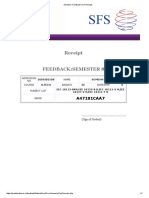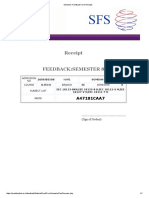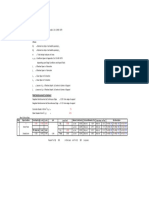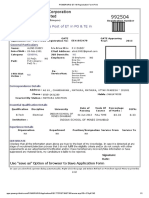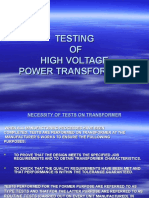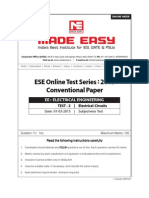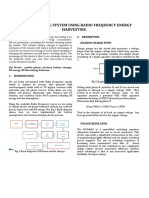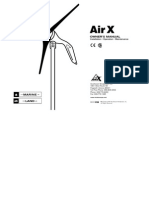Ies SyllabusBooks For Ies
Ies SyllabusBooks For Ies
Uploaded by
Alind DubeyCopyright:
Available Formats
Ies SyllabusBooks For Ies
Ies SyllabusBooks For Ies
Uploaded by
Alind DubeyOriginal Description:
Original Title
Copyright
Available Formats
Share this document
Did you find this document useful?
Is this content inappropriate?
Copyright:
Available Formats
Ies SyllabusBooks For Ies
Ies SyllabusBooks For Ies
Uploaded by
Alind DubeyCopyright:
Available Formats
Electrical Machines and Power Transformers
Magnetic Circuits - Analysis and Design of Power transformers. Construction and testing. Equivalent
circuits. Losses and efficiency. Regulation. Auto-transformer, 3-phase transformer. Parallel operation.
Basic concepts in rotating machines- EMF, torque, basic machine types. Construction and operation,
leakage losses and efficiency.
B.C. Machines- Construction, Excitation methods. Circuit models. Armature reaction and commutation.
Characteristics and performance analysis. Generators and motors. Starting and speed control. Testing,
Losses and efficiency. Synchronous Machines- Construction. Circuit model. Operating characteristics and
performance analysis. Synchronous reactance. Efficiency. Voltage regulation. Salient-pole machine,
Parallel operation. Hunting. Short circuit transients.
Induction Machines- Construction. Principle of operation. Rotating fields. Characteristics and
performance analysis. Determination of circuit model. Circle diagram. Starting and speed control.
Fractional KW motors. Single-phase synchronous and induction motors.
Power systems
Types of Power Stations, Hydro, Thermal and Nuclear Stations. Pumped storage plants. Economics and
operating factors.
Power transmission lines- Modeling and performance characteristics. Voltage control. Load flow studies.
Optimal power system operation. Load frequency control. Symmetrical short circuit analysis. ZBus
formulation. Symmetrical Components. Per Unit representation. Fault analysis. Transient and steadystate stability of power systems. Equal area criterion.
Power system Transients- Power system Protection Circuit breakers. Relays. HVDC transmission.
Analog and Digital Electronics and Circuits
Semiconductor device physics, PN junctions and transistors, circuit models and parameters, FET, Zener,
tunnel, Schottky, photo diodes and their applications, rectifier circuits, voltage regulators and
multipliers, switching behavior of diodes and transistors.
Small signal amplifiers, biasing circuits, frequency response and improvement, multistage amplifiers and
feed-back amplifiers, D.C. amplifiers, Oscillators. Large signal amplifiers, coupling methods, push pull
amplifiers, operational amplifiers, wave shaping circuits. Multivibrators and flip-flops and their
applications. Digital logic gate families, universal gates-combination circuits for arithmetic and logic
operational, sequential logic circuits. Counters, registers, RAM and ROMs.
Microprocessors
Microprocessor architecture-Instruction set and simple assembly language programming. Interfacing for
memory and I/O. Applications of Micro-processors in power system.
Communication Systems
Types of modulation; AM, FM and PM. Demodulators. Noise and bandwidth considerations. Digital
communication systems. Pulse code modulation and demodulation. Elements of sound and vision
broadcasting. Carrier communication. Frequency division and time division multiplexing, Telemetry
system in power engineering.
Power Electronics
Power Semiconductor devices Thyristor. Power transistor, GTOs and MOSFETS. Characteristics and
operation. AC to DC Converters; 1-phase and 3-phase DC to DC Converters; AC regulators. Thyristor
controlled reactors; switched capacitor networks.
Inverters; single-phase and 3-phase Pulse width modulation. Sinusoidal modulation with uniform
sampling. Switched mode power supplies.
EM Theory
Electric and magnetic fields. Gausss Law and Amperes Law. Fields in dielectrics, conductors and
magnetic materials. Maxwells equations. Time varying fields. Plane-Wave propagating in dielectric and
conducting media. Transmission lines.
Electrical Materials
Band Theory, Conductors, Semi-conductors and Insulators. Super-conductivity. Insulators for electrical
and electronic applications. Magnetic materials. Ferro and ferri magnetism. Ceramics, Properties and
applications. Hall effect and its applications. Special semi conductors.
Electrical Circuits
Circuits elements. Kirchoffs Laws. Mesh and nodal analysis. Network Theorems and applications. Natural
response and forced response. Transient response and steady state response for arbitrary inputs.
Properties of networks in terms of poles and zeros. Transfer function. Resonant circuits. Threephase
circuits. Two-port networks. Elements of two-element network synthesis.
Measurements and Instrumentation
Units and Standards. Error analysis, measurement of current, Voltage, power, Power-factor and energy.
Indicating instruments. Measurement of resistance, inductance, Capacitance and frequency. Bridge
measurements. Electronic measuring instruments. Digital Voltmeter and frequency counter. Transducers
and their applications to the measurement of non-electrical quantities like temperature, pressure, flowrate displacement, acceleration, noise level etc. Data acquisition systems. A/D and D/A converters.
Control Systems
Mathematical modelling of physical systems. Block diagrams and signal flow graphs and their reduction.
Time domain and frequency domain analysis of linear dynamical system. Errors for different type of
inputs and stability criteria for feedback systems. Stability analysis using Routh-Hurwitz array, Nyquist
plot and Bode plot. Root locus and Nicols chart and the estimation of gain and phase margin. Basic
concepts of compensator design. State variable matrix and its use in system modelling and design.
Sampled data system and performance of such a system with the samples in the error channel. Stability
of sampled data system. Elements of non-linear control analysis. Control system components,
electromechanical, hydraulic, pneumatic components.
You might also like
- Electrical System Cessna 152Document4 pagesElectrical System Cessna 152JoséMendes100% (1)
- 27 - 279598 - LP03044-0, LP030345-0, LP030419-0 Generator Service ManualDocument15 pages27 - 279598 - LP03044-0, LP030345-0, LP030419-0 Generator Service ManualBigDon1955No ratings yet
- SPSC SyllabusDocument3 pagesSPSC SyllabusNirmal SharmaNo ratings yet
- ISO 9001, ISO 14001: LG Low Voltage Air Circuit BreakersDocument24 pagesISO 9001, ISO 14001: LG Low Voltage Air Circuit BreakersDong BachNo ratings yet
- Ies Syllabus PDFDocument2 pagesIes Syllabus PDFSK PNo ratings yet
- Paper-1: IES Electrical Engineering SyllabusDocument3 pagesPaper-1: IES Electrical Engineering SyllabusJampana ShivaramakrishnaNo ratings yet
- Electrical Engineering Paper - I 1. EM TheoryDocument3 pagesElectrical Engineering Paper - I 1. EM TheorySumanth YalagandulaNo ratings yet
- Syllabus Electrical Engg CseDocument7 pagesSyllabus Electrical Engg CseKrishna Mohan ChauhanNo ratings yet
- Electrical Machines and Power TransformersDocument2 pagesElectrical Machines and Power TransformersMichael DavisNo ratings yet
- Electrical Engineering: Objective: - 120 Que Stions Subjective: - 6 Que Stions Paper-I EM TheoryDocument3 pagesElectrical Engineering: Objective: - 120 Que Stions Subjective: - 6 Que Stions Paper-I EM TheoryshonujamNo ratings yet
- Electrical Engg - Syllabus For IesDocument3 pagesElectrical Engg - Syllabus For IesmathiilangoNo ratings yet
- Paper I Syllabus: 1. EM Theory Electric and Magnetic FieldsDocument3 pagesPaper I Syllabus: 1. EM Theory Electric and Magnetic FieldsankitNo ratings yet
- CCCC C C C CCDocument3 pagesCCCC C C C CCManoj MeenaNo ratings yet
- SylubusDocument7 pagesSylubusnitnannuNo ratings yet
- EM Theory: Electrical Engineering Paper - IDocument3 pagesEM Theory: Electrical Engineering Paper - Iparth_singh_6No ratings yet
- Indicative Syllabus of Electrical EngineeringDocument3 pagesIndicative Syllabus of Electrical EngineeringRishabh RanaNo ratings yet
- Electrical Engineering Syllabus For IES Exam: Paper IDocument6 pagesElectrical Engineering Syllabus For IES Exam: Paper IKarthik MurganNo ratings yet
- IES Electrical Engg.Document2 pagesIES Electrical Engg.Anil BishnoiNo ratings yet
- D) Electrical Engineering Syllabus Ies 2015: Paper I 1. EM TheoryDocument4 pagesD) Electrical Engineering Syllabus Ies 2015: Paper I 1. EM TheorysyamalaNo ratings yet
- Syllabus ESEDocument3 pagesSyllabus ESESuvra PattanayakNo ratings yet
- PSU's Common Syllabus For Electrical Engineering Non-Technical: General StudyDocument2 pagesPSU's Common Syllabus For Electrical Engineering Non-Technical: General StudyJitendra TambeNo ratings yet
- em Theory:: Paper IDocument3 pagesem Theory:: Paper IDeepthi Madhav AnnavarapuNo ratings yet
- IES Books& SyllabusDocument4 pagesIES Books& SyllabusRajesh KumarNo ratings yet
- Elect Et Syllabus 2013 For SJVNDocument3 pagesElect Et Syllabus 2013 For SJVNBest KvansNo ratings yet
- IES Electrical Engineering SyllabusDocument4 pagesIES Electrical Engineering SyllabusAvinash Arya100% (1)
- Syllabus of Electrical Engineering PrelimsDocument3 pagesSyllabus of Electrical Engineering Prelimsapi-3710029No ratings yet
- Syllabus For IESDocument3 pagesSyllabus For IESSaranya PrabagaranNo ratings yet
- Power Electronics and Drives: Semiconductor Power Diodes, Transistors, Thyristors, TriacsDocument2 pagesPower Electronics and Drives: Semiconductor Power Diodes, Transistors, Thyristors, TriacsSunilkumarNo ratings yet
- Upsc CSE Ele SyllabusDocument2 pagesUpsc CSE Ele SyllabusgppNo ratings yet
- Paper - I 1. Circuit Theory:: Electrical EngineeringDocument3 pagesPaper - I 1. Circuit Theory:: Electrical EngineeringEr Paramjit SinghNo ratings yet
- Ies SyllabusDocument3 pagesIes SyllabusBhaskarReddyVangalaNo ratings yet
- Electrical Engineering Paper - I: 1. EM TheoryDocument4 pagesElectrical Engineering Paper - I: 1. EM TheoryDinesh KumarNo ratings yet
- Electrical EngineeringDocument2 pagesElectrical Engineeringrjrahul25No ratings yet
- RSMSSB JEN Electrical SyllabusDocument2 pagesRSMSSB JEN Electrical Syllabusashwinivema1980No ratings yet
- Electrical Engg SyllabusDocument6 pagesElectrical Engg Syllabuschirag_cs7No ratings yet
- Electrical Engineering Syllabus For IESDocument3 pagesElectrical Engineering Syllabus For IESSanjay YadavNo ratings yet
- Electrical SyllabusDocument2 pagesElectrical SyllabusSumit SinghNo ratings yet
- Apspdcl Ae SyllabusDocument1 pageApspdcl Ae SyllabusJanjanam PraveenNo ratings yet
- Ap Eee SyllabusDocument3 pagesAp Eee SyllabusSujith kumarNo ratings yet
- Electrical Main Syll IasDocument3 pagesElectrical Main Syll IasRNikaNo ratings yet
- Eletrical SyllabusDocument3 pagesEletrical SyllabusRadhey LoyaNo ratings yet
- Genco Syllabus For EEE BranchDocument2 pagesGenco Syllabus For EEE BranchMansa ManuNo ratings yet
- B.Tech. (IEE) Syllabus (New) : First Year First SemesterDocument26 pagesB.Tech. (IEE) Syllabus (New) : First Year First SemesterAnasua SarkarNo ratings yet
- Electrical Engineering Syllabus For UPSC Main ExaminationDocument3 pagesElectrical Engineering Syllabus For UPSC Main ExaminationsujaraghupsNo ratings yet
- UPSC CSE Electrical Engineering SyllabusDocument2 pagesUPSC CSE Electrical Engineering Syllabusbpsharmab1p1No ratings yet
- Digital Signal Processing by Ramesh BabuDocument1 pageDigital Signal Processing by Ramesh BabuSubhankar DeyNo ratings yet
- A N Ne X U R E Syllabus (For Electrical Branch/AE) : 1. Electrical Circuits and NetworksDocument1 pageA N Ne X U R E Syllabus (For Electrical Branch/AE) : 1. Electrical Circuits and NetworksshafibhaiNo ratings yet
- Gate 2012 Slybus Ee&EcDocument2 pagesGate 2012 Slybus Ee&EcAkku MumbaiNo ratings yet
- En Ee Gate SyllabuDocument3 pagesEn Ee Gate SyllabunavneetNo ratings yet
- Branch/Discipline: Electrical EngineeringDocument3 pagesBranch/Discipline: Electrical EngineeringsixfacerajNo ratings yet
- Indicative SyllabusDocument2 pagesIndicative Syllabusstudyking408No ratings yet
- UPSC Syllabus Electrical EngineeringDocument3 pagesUPSC Syllabus Electrical EngineeringMOHD ALI SHAMSINo ratings yet
- Ne01 Scto Electrical / Electronics & TelecommunicationDocument4 pagesNe01 Scto Electrical / Electronics & TelecommunicationvivekNo ratings yet
- Syllabus Mains of Electrical EngineeringDocument3 pagesSyllabus Mains of Electrical Engineeringapi-3710029No ratings yet
- D5A68CD2-1A26-4BDD-A5F6-2A1C22A40C58Document3 pagesD5A68CD2-1A26-4BDD-A5F6-2A1C22A40C58BapuNo ratings yet
- Tamil Nadu Public Service Commission: Code No.206Document4 pagesTamil Nadu Public Service Commission: Code No.206Kaviarasu ThangarajNo ratings yet
- BE-EEE Courses DescriptionDocument7 pagesBE-EEE Courses DescriptionShrayan BarmanNo ratings yet
- 137APGENCO ASSISTANT ENGINEERS Electical SyllabusDocument2 pages137APGENCO ASSISTANT ENGINEERS Electical SyllabusbadriNo ratings yet
- Electrical Engineering (Code No. 13)Document1 pageElectrical Engineering (Code No. 13)shwetagurjarNo ratings yet
- M.tech Syllabus Jamia University DelhiDocument1 pageM.tech Syllabus Jamia University Delhidheerajdb99No ratings yet
- Power Electronics and Energy Conversion Systems, Fundamentals and Hard-switching ConvertersFrom EverandPower Electronics and Energy Conversion Systems, Fundamentals and Hard-switching ConvertersNo ratings yet
- Power Electronics: Lecture Notes of Power Electronics CourseFrom EverandPower Electronics: Lecture Notes of Power Electronics CourseNo ratings yet
- 2x600 MW CHP, Damodar Valley Corporation, Raghunathpur (W.B)Document1 page2x600 MW CHP, Damodar Valley Corporation, Raghunathpur (W.B)Alind DubeyNo ratings yet
- Hindustan Petroleum Corporation Limited: Thank You For Visiting HPCL Job Site.Document1 pageHindustan Petroleum Corporation Limited: Thank You For Visiting HPCL Job Site.Alind DubeyNo ratings yet
- Semester Feedback Form Receipt Somesh PDFDocument1 pageSemester Feedback Form Receipt Somesh PDFAlind DubeyNo ratings yet
- Analog Circuits Design: Electronics Club, IIT KanpurDocument11 pagesAnalog Circuits Design: Electronics Club, IIT KanpurAlind DubeyNo ratings yet
- Engineer Trainee 2013-14 Gen: BHELDocument3 pagesEngineer Trainee 2013-14 Gen: BHELAlind DubeyNo ratings yet
- ReceiptDocument1 pageReceiptAlind DubeyNo ratings yet
- Rohtak1 Opt 2Document1 pageRohtak1 Opt 2Alind DubeyNo ratings yet
- 1234Document1 page1234Alind DubeyNo ratings yet
- I Es Conventional Paper Electrical 1987Document6 pagesI Es Conventional Paper Electrical 1987Alind DubeyNo ratings yet
- ResumeDocument3 pagesResumeAlind DubeyNo ratings yet
- Testing of Power TransformersDocument30 pagesTesting of Power TransformersAlind Dubey100% (3)
- ESE Online Test Series: 2015 Conventional Paper: Ee: Electrical EngineeringDocument4 pagesESE Online Test Series: 2015 Conventional Paper: Ee: Electrical EngineeringAlind DubeyNo ratings yet
- Ida OdaDocument3 pagesIda OdaAlind DubeyNo ratings yet
- Technical Data Book of NGRDocument54 pagesTechnical Data Book of NGRAlind Dubey0% (1)
- Bus Bar and LBB Protection PDFDocument33 pagesBus Bar and LBB Protection PDFAlind Dubey100% (6)
- CM20180525 33756 27354Document10 pagesCM20180525 33756 27354BASEM NOMAN ALI MOHAMMEDNo ratings yet
- NEON LampDocument14 pagesNEON LampVijay GajjalaNo ratings yet
- AVC Sensing ModuleDocument2 pagesAVC Sensing Modulerodruren01No ratings yet
- How To Select Genset PDFDocument25 pagesHow To Select Genset PDFSaraswatapalit100% (1)
- Infineon Catalog 1Document40 pagesInfineon Catalog 1arielfoxtoolsNo ratings yet
- Mobile Charging System Using Radio Frequency Energy HarvestingDocument3 pagesMobile Charging System Using Radio Frequency Energy HarvestingBrightworld ProjectsNo ratings yet
- Solar Wind Hybrid Inverter IEEE Word FormatDocument3 pagesSolar Wind Hybrid Inverter IEEE Word FormatAshutoshNo ratings yet
- Generators Portable Ultrasilent DCA125USI Rev 1 60 HZ Manual DataId 19064 Version 1Document90 pagesGenerators Portable Ultrasilent DCA125USI Rev 1 60 HZ Manual DataId 19064 Version 1Duy Kha100% (2)
- Portable Smart Phone Charger Using HumanDocument6 pagesPortable Smart Phone Charger Using HumanKipkoech FrankNo ratings yet
- Atx2005r10atx 2099665633Document7 pagesAtx2005r10atx 2099665633freddyNo ratings yet
- Report On Aircraft Electrical Systems BackgroundDocument5 pagesReport On Aircraft Electrical Systems BackgroundRahul ChandranNo ratings yet
- UCM224D - Technical Data SheetDocument8 pagesUCM224D - Technical Data Sheet3efooNo ratings yet
- Design of Power System Stabilizer PDFDocument68 pagesDesign of Power System Stabilizer PDFNuraddeen MagajiNo ratings yet
- Cu0114 - WP - Electricity For Hospitals - v2Document27 pagesCu0114 - WP - Electricity For Hospitals - v2idgesrlNo ratings yet
- EE40, Spring 2015, Pre-Lab 3 LED Circuit and Voltage Regulator CircuitDocument4 pagesEE40, Spring 2015, Pre-Lab 3 LED Circuit and Voltage Regulator CircuitJack LongNo ratings yet
- 8.13 Compound Generator: F F Res F F Crit FDocument3 pages8.13 Compound Generator: F F Res F F Crit FAum4Eng HelpNo ratings yet
- DG274DDocument8 pagesDG274DJakchai powerNo ratings yet
- LM723 STMicroelectronicsDocument12 pagesLM723 STMicroelectronicssuppoNo ratings yet
- VR ParallelDocument29 pagesVR ParallelMohamed RashidNo ratings yet
- Voltage Regulation of Single Phase TransformerDocument6 pagesVoltage Regulation of Single Phase TransformerMuhammad Ali HaiderNo ratings yet
- QSX15 SpecDocument4 pagesQSX15 Specpdealers100% (1)
- Automatic Generation ControlDocument12 pagesAutomatic Generation ControlmelakudagnewNo ratings yet
- Sastra Universiy: B.Tech (Eee) ProgrammeDocument13 pagesSastra Universiy: B.Tech (Eee) ProgrammeSriram VenkatachariNo ratings yet
- Design and Construction of Home Appliances Control Using BluetoothDocument49 pagesDesign and Construction of Home Appliances Control Using BluetoothAdeniji IsraelNo ratings yet
- KTU EDC Previous Question PapersDocument12 pagesKTU EDC Previous Question PapersVarun DevNo ratings yet
- Features Applications: General DescriptionDocument9 pagesFeatures Applications: General DescriptionAntony Valan.SNo ratings yet
- Air X ManualDocument32 pagesAir X ManualJim Hero100% (1)









